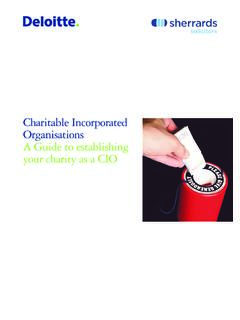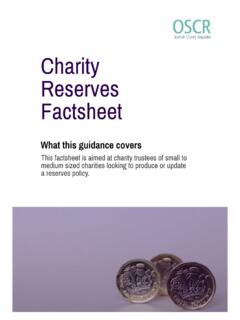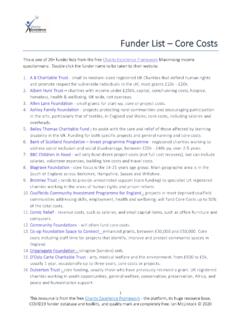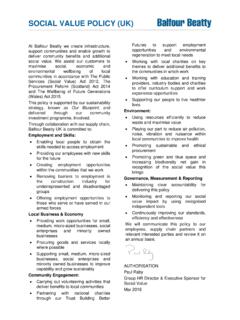Transcription of Chapter 2: Due diligence, monitoring and verifying the …
1 COMPLIANCE TOOLKIT: PROTECTING charities FROM HARMC hapter 2: Due diligence , monitoring and verifying the end use of charitable fundsSEPTEMBER 2016 Chapter 2: Due diligence , monitoring and verifying the end use of charitable funds1 Contents1. Introduction 22. Trustees' duties and responsibilities 53. The risk based approach 84. The 'know your' principles 145. Know your donor 166. Know your beneficiaries 237. Working with partners and protecting the charity 288. Know your partner 319. monitoring 3810. charities operating internationally 5211. Technical terms used 5912. Further information 61 Chapter 2: Due diligence , monitoring and verifying the end use of charitable funds21. IntroductionThe public and those donating to charity should have confidence that money donated is used for legitimate purposes and is reaching its intended beneficiaries. Trustees are legally responsible for ensuring that charitable funds are properly used, adequately protected, and not misused for financial crime, terrorist or other criminal purposes.
2 Trustees are publicly accountable, and have duties and responsibilities under charity law to safeguard their charity, its funds, property and beneficiaries. They may have employees, volunteers and agents to help, but trustees remain legally best way that trustees can ensure a charity's funds are not abused is by putting in place good governance and ensuring there is strong financial management, including robust internal and financial controls and risk management procedures. They should also promote the transparency and accountability of charities and ensure that the public can have trust and confidence in charities and their diligenceDue diligence is the range of practical steps that need to be taken by trustees in order to be assured of the provenance of charitable funds and confident that they know the people and organisations the charity works with, and able to identify and manage associated risks.
3 'Due diligence ' is an important part of trustee duty and is essential in safeguarding charity assets. It means carrying out proper 'checks' on those individuals and organisations that give money to, or receive money from, the charity, including partners and others that are contracted to work with charities give money to partners and beneficiaries, especially large amounts of money or in high risk situations, it's vital to ensure that adequate ' monitoring ' takes place. In short, trustees should take appropriate steps to verify that charity funds or property reach their proper destinations and are used how the charity intended. This will allow trustees to have clear oversight of how charity funds are used across the full scope of its operation, whether nationally or What is the purpose of this Chapter ?Protecting charities from harm is guidance designed to help trustees be clear about what their legal duties and responsibilities are and what approach they 'must' (legal requirement) or 'should' (good practice) take for their charity and its work.
4 This approach will depend upon a range of factors, including the nature of charity work and associated risk, the amount of money involved and whether partner organisations operate overseas, particularly in high risk areas. This Chapter explains in detail how trustees can carry out due diligence and monitoring and outlines practical steps they can take to protect their charity's assets, work and reputation. The 'know your' principles section in this Chapter will help trustees understand how to comply with legal requirements, particularly when working with partners overseas and in verifying the proper application of charitable funds. The guidance identifies good practice examples and uses case studies to illustrate how the legal duties might apply in practice. Who will benefit from this Chapter ?This Chapter is primarily intended for trustees, but will also be of interest to donors and organisations which give grants to charities to deliver project work in the UK and internationally, so they understand what trustees' responsibilities are under charity law.
5 The 'tools' are particularly aimed at smaller and medium sized charities . The guidance will also assist partner organisations and other delivery agents which charities engage to carry out their work and help them to understand why a charity may have need of certain reporting requirements or information from 2: Due diligence , monitoring and verifying the end use of charitable Due diligenceDue diligence will usually involve judging the quality and completeness of initial information obtained and then deciding whether further checks or enquiries are work in a diverse range of situations with a wide range of beneficiaries. Some individuals and organisations donate regularly to charity and have a good, close working relationship. Other donors want to remain anonymous. Both these arrangements are perfectly acceptable and reasonable. It just means charities may need to put in place additional safeguards to protect themselves against those who want to take advantage, while ensuring this does not put off legitimate 'know your' principlesThe 'know your' principles section sets out key principles that will help charity trustees to carry out their legal duties and manage the risks to the charity's assets and services.
6 The 'know your' principles are already part of the legal duties and responsibilities of trustees in charity law. They are not new obligations for trustees. Similar 'know your' principles and responsibilities exist in other charities , they can be described in the following three 'know your' principles: know your donor know your beneficiaries know your partner Applying the 'know your' principles to due diligence and monitoring will help charity trustees to be reasonably assured of the provenance of funds given to their charity, confident that they know the people and organisations they work with, and are able to identify and manage any associated 'know your' principles will apply differently to different circumstances. Due diligence needs to take into consideration that, in some cases, charitable activity will be delivered more effectively through partner organisations - perhaps because they know the charity's intended beneficiaries or are located near them.
7 Those partner organisations' credentials, processes and systems can be evaluated. In other cases, assistance and aid may need to be delivered by the charity direct to communities and individual 'know your' principles also complement and are in line with internationally recognised standards, such as those set out in Financial Action Task Force Special Recommendation VIII (FATF SR VIII): charities should make best efforts to confirm the identity, credentials and good standing of their beneficiaries and associates undertake best efforts to document the identity of their significant donors . MonitoringGood monitoring procedures help trustees to fulfil their legal duty to ensure that charitable funds are used for the purposes they should be and reach their intended recipients. They can also help trustees assess and review the key risks to the charity and its funds.
8 The procedures, controls and systems a charity needs to use will depend on the charity and its activities and a number of other factors. There are some things a charity must do as a matter of law. Aside from those, the nature and the extent of the monitoring should be proportionate to the level of risk the charity is exposed 2: Due diligence , monitoring and verifying the end use of charitable Risk based approachWhy a risk based approach?The commission will always support charities to deliver legitimate humanitarian aid and other charitable services. The commission appreciates the challenges that some charities may face. This includes, for example, charities working in areas where corruption, violence, or serious or organised crime is common practice, or terrorists and other criminals are known to operate, perhaps where they have some degree of control over access to people in need.
9 For other charities the risks are low. Their activities may be straightforward, they may carry them out themselves, they may collect and use little money and transactions may be less complex. This is why a risk-based and proportionate approach is important and more appropriate than a 'one-size-fits-all' based approach in practiceTrustees' legal duties and responsibilities apply to all charities and all trustees, whatever the charity, its size and activities. What this means in practice however depends on the circumstances. The extent, form and detail of the project and partner monitoring checks and due diligence that is required, and how this should extend to donors and beneficiaries, will depend on the nature of the risks in the particular circumstances. The level of checks and procedures required will be dependent on the nature of the activities the charity carries out, and how and where they are undertaken.
10 Where the risks are high - such as in areas where it is well known or likely that proscribed and other terrorist organisations are known to operate - trustees must ensure those steps are sufficiently robust. In this guidance the commission illustrates how these duties may apply in practice for different charities through case studies and starting point is: the greater the risks, the more charity trustees need to do to mitigate 2: Due diligence , monitoring and verifying the end use of charitable funds52. Trustees' duties and What are trustees' legal duties and responsibilities for due diligence ?The short answer (legal requirement)Charity trustees must use their charity's funds and assets only in furtherance of the charity's purposes. They must avoid undertaking activities that might place the charity's funds, assets or reputation at undue practice, this means that to meet their legal duty to protect charity assets with the necessary care and properly to assess risk, trustees must carry out appropriate due diligence on those individuals and organisations that the charity receives donations from, gives money to or works with more detailLegal requirement: trustees have ultimate responsibility for controlling and managing the affairs of a charity.

















